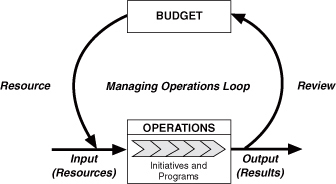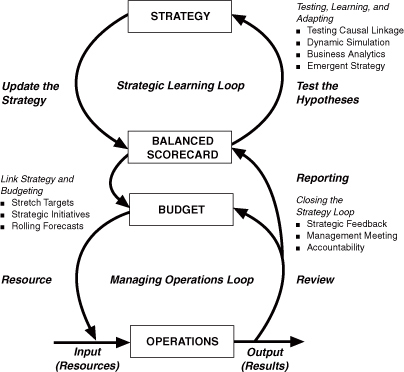
 P A R T F O U R
P A R T F O U R
 P A R T F O U R
P A R T F O U RMAKING STRATEGY A CONTINUAL PROCESS
IN CHAPTER 1, WE NOTED HOW MOST COMPANIES ENCOUNTER serious difficulties when implementing strategy. Our research indicates that the problem is more than a failure of CEO leadership. Systemic forces in organizations inhibit strategy implementation. As researchers have observed, managing strategy is fundamentally different from managing operations.1
We have found it useful to think of each of these processes—managing strategy and managing operations—as a self-contained control and learning loop. For managing operations, the budget serves as the planning and control system (see Figure IV-1). It defines the resources that will be allocated to business unit operations for the subsequent year, and the performance targets. During the year, managers review operating performance against the budget, identify variances, and take corrective action when necessary. In most organizations, the budget bears little relation to the organization’s strategy, so management attention and actions are directed at short-term operational details, not implementation of the long-term strategy.
Yet organizations are becoming increasingly frustrated with the inflexibility of their budgeting process. Recent surveys have found that
 20 percent of organizations take more than sixteen weeks to prepare a budget, with many budgets not even completed by the
start of the fiscal year.
2
20 percent of organizations take more than sixteen weeks to prepare a budget, with many budgets not even completed by the
start of the fiscal year.
2
 78 percent of companies do not change their budgets within the fiscal cycle.
3
The world may change, but not their budgets.
78 percent of companies do not change their budgets within the fiscal cycle.
3
The world may change, but not their budgets.
Figure IV-1 The Problem: The Process for Managing Strategy Is Missing

While the budget-based operations control process may have limitations in a dynamic, rapidly changing world, it at least exists. Most organizations don’t have any process for managing strategy. Consider the following facts.
 85 percent of management teams spend less than one hour per month discussing strategy
4
85 percent of management teams spend less than one hour per month discussing strategy
4
 60 percent of organizations don’t link strategy and budgeting
5
60 percent of organizations don’t link strategy and budgeting
5
 92 percent of organizations don’t report on strategic lead indicators
6
92 percent of organizations don’t report on strategic lead indicators
6
If this were a human system instead of a management system, we would be observing quite a sick patient. The brain is not functioning (no time is spent thinking about strategy), the body is not receiving any messages from the brain (there is no linkage from strategic intent to action), and the eyes are not observing (there is no feedback). With such a sick management system, is it any surprise that few companies can execute their strategies?
Strategy-Focused Organizations use a “double-loop” process that integrates the management of budgets and operations with the management of strategy. A reporting system, based on the Balanced Scorecard, allows progress against the strategy to be monitored and corrective actions to be taken as required. The scorecard serves as the linchpin of the strategic learning process, linking the operations control process with the learning and control process for managing strategy.
This new strategy-focused management system (see Figure IV-2) introduces three remedies to restore the management system to health:
Figure IV-2 The Solution: Make Strategy a Continual Process

With the strategy-focused management system, management teams
 monitor performance against the strategy
monitor performance against the strategy
 work as teams to interpret the data
work as teams to interpret the data
 develop new strategic insights
develop new strategic insights
 formulate new strategic directions
formulate new strategic directions
 update the measures on scorecards
update the measures on scorecards
 change their budgets
change their budgets
Strategy-Focused Organizations must be able to adapt their strategies as the world changes or the strategy matures. The double-loop strategic management system provides the foundation for making strategy a continual process.
1. For example, Robert N. Anthony identifies three layers to the management process: (1.) Strategic planning: the process of deciding on the organization’s objectives, on changes in these objectives, on the resources used to attain these objectives, and the policies to govern their acquisition and use; (2.) Management control: the process by which managers ensure that resources are obtained and used efficiently and effectively in accomplishing the organization objectives; and (3.) Operational control: the process of ensuring that specific tasks are carried out efficiently and effectively. Robert N. Anthony, Planning and Control Systems (Boston: Division of Research, Graduate School of Business Administration, Harvard University, 1965).
2. “Many Companies Starting the New Millennium without a Budget,” PR Newswire, 16 December 1999.
3. “Corporate Strategic Planning Suffers from Inefficiencies,” Hackett Benchmarking PR Newswire, 25 October 1999.
4. David P. Norton, “Building a Management System to Implement Your Strategy,” Point of View, Renaissance Solutions, Inc., Lincoln, MA, 1996.
5. Ibid.
6. “Corporate Strategic Planning.”